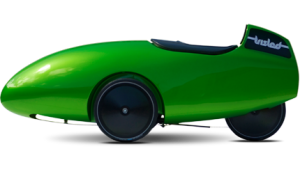 Trisled have brought out a new variant of the Rotovelo, their robust budget priced velomobile. The Rotovelo Carbon is, as it’s name suggests, is made in the same shape as the original Rotovelo but with a body of carbon fibre instead of the original roto-molded HDPE. We briefly mentioned the body material advantage of the original design in a post regarding the sale of the machine reviewed by Velovision Magazine (Issue 41 Jun 2011).
Trisled have brought out a new variant of the Rotovelo, their robust budget priced velomobile. The Rotovelo Carbon is, as it’s name suggests, is made in the same shape as the original Rotovelo but with a body of carbon fibre instead of the original roto-molded HDPE. We briefly mentioned the body material advantage of the original design in a post regarding the sale of the machine reviewed by Velovision Magazine (Issue 41 Jun 2011).
What was not mentioned was the bare-bones spec, which includes no installed suspension system and simple cruciform frame, since the body is not sufficiently capable of carrying load. The specification is justified as part of a design whose objective is robust simplicity and low cost. That this bare-bones spec has been translated directly to a machine with a costly and relatively fragile body has raised a lot of comment and questions along the lines of, “what are they thinking!?”
The following short video by Trisled illustrates the Rotovelo Carbon in action.
A typical velomobile can be expected to weight upward of 30 kg with the sporty machines weighing in the mid 20s. Perhaps the lightest of these is the Go-one Evo-Ks at 21.5 kg for the bare model. What Trisled have achieved with the Rotovelo Carbon is a low weight – obviously depending on component choice, as low as 19.5 kg (the same weight as my Claude Butler run-about bike!) Given the attractive weight there are some saying, if the Rotovelo Carbon came with suspension they would have one, and it is claimed to be the most asked for feature for the original Rotovelo, so what gives?
Firstly there is a weight saving by excluding active suspension, so the record low would not be possible otherwise. Secondly there is a helpful and fairly extensive rider report on the Rotovelo on the Bentrider Online forum by mikeatlbch which gives a more balanced perspective and argues that for most practical cases active suspension is not needed. One thing he highlights from his own experience is the passive suspension provided by the Rotovelo frame. While he still prefers the HDPE body for its ability to take the knocks he appreciates the value low weight would offer in a stop-and-go urban environment where ease of acceleration and therefore low weight is important.
So while the armchair velonaut, accustomed to ever increasing technical complexity, may be puzzled: what Trisled have produced is, from their perspective, a logical compromise; satisfied with the ride performance of the original Rotovelo, they have traded a robust body for easier acceleration. It remains to be seen whether there are buyers who agree with them.

